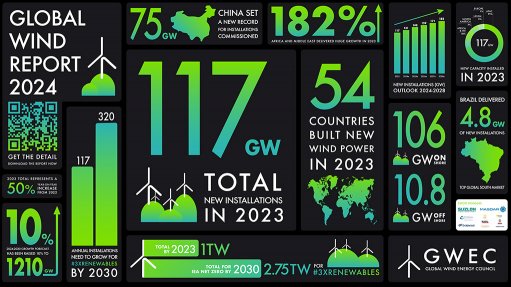FA 13 Speeding up the energy turnaround
This article has been supplied as a media statement and is not written by Creamer Media. It may be available only for a limited time on this website.
Company Announcement - Turning away from nuclear energy and less use of fossil fuels – countries such as Germany are adding more speed to the energy turnaround. However, not only is there a lack of sufficiently developed power grids, but also of energy storage systems. New grids need to be rolled out and a still young technology called Power to Gas could level out wind and solar energy fluctuations in the future. The energy turnaround can only work with the proper valves. Either way, nature takes its course – mankind can't change a thing about it. If the sun shines and the wind blows, lots of energy is produced, yet not all of it can be feed into the power grid, or stored. The reverse case also poses problems: if the sun is hiding behind dense clouds and no wind is blowing, the energy yield suffers markedly. A supply gap threatens. The ideal solution therefore would be to store excess power when too much of it is generated, and use it if there is a shortage. „When renewables dominate power supply in the future, great amounts of power require long-term storage, in order to bridge periods with less wind and sun“, emphasises Stephan Kohler, chairman of the board of directors of the German Energy Agency (dena).
Not enough pump storage
At least that's the theory. As a matter of fact, excess renewable power “can't simply be stored in the power grid. Generation and consumption have to take place at the same time,” explains the German Zentrum für Sonnenenergie- und Wasserstoff-Forschung Baden-Württemberg (Centre for Solar Power and Hydrogen Research Baden Wuerttemberg, ZSW). So far, existing pump storage plants are used to store excess power. However, in the case of an emergency they are only able to store Germany's entire power requirement for less than an hour, on paper. “This is clearly not enough,“ states the ZSW. This technology can – even if expanded – not close the gap, mere only alleviate it. In order to solve the problem, the so-called Power to Gas technology has been in development for several years. Power to Gas technology is now technologically viable, but is not without controversy. Experts believe Power to Gas is too ineffective and uneconomical, in its current state. Dena seems to be aware there is reason to act: “for the long-term necessary option of re-electrification, i.e. the use of Power to Gas as energy store with utilisation of the natural gas infrastructure, the system efficiency factor has to be clearly improved“.
Power to Gas pilot projects
This shows itself in the dena roadmap and its action plan, which sees the large-scale technological and economical application of Power to Gas by 2022 in Germany, with a projected capacity of 1.000 Mwel. The current status quo thus is to use existing plants as pilot and demonstration plants with hope for a good mid- or long-term perspective for energy supply. As of January 2014, ten plants were operational in Germany, while 15 Power to Gas projects are being built, or still in the planning phase.
Power to Gas means converting power into gas. Power to Gas plants utilise a storage technology to integrate renewables into the energy system. “Excess power, for instance from wind power stations, are used to create hydrogen from water through electrolysis,“ dena explains. Carbon dioxide is used in a second step to turn the hydrogen into methane. CO2 from industrial production, breweries, sewage gas, the ethanol industry, biogas plants and – when processed – from the surrounding air can be used. There are around 6.000 biogas plants in Germany alone.
Long-term gas storage
“The synthetic natural gas or hydrogen can be stored for long periods in the existing natural gas infrastructure and can find various uses – for re-electrification and heat or as fuel“, explains the “Strategy Platform Power to Gas“. It could thus be used to fuel mobility, next to being used by industry and private households. The technology “enables the deployment of zero-emission and highly efficient hydrogen fuel cell automobiles“, explains Werner Diwald, member of the board of Enertrag AG. As such, it is seen as a cross-system technology. Valves “pave“ the entire path of energy. Already beginning with power generation through wind and sun, valves are an absolutely essential component. Renewables create a new chain of plants and facilities. Will Power to Gas plants be a future part of the equation?
Valves are essential
Valves are also an indispensable component of Power to Gas plants. The sector can participant in numerous ways in the continued development of this technology. Valves are for instance used in water electrolysis, re-electrification of hydrogen into power in gas power plants, for feeding hydrogen into the public natural gas grid, for gas stations – including logistics – or for methane production and fuel cells. Valves are essential. Without them fluids such as water, hydrogen, oxygen, methane or natural gas cannot be used purposefully. Due to the numerous fields of application all known sorts of valves are used, including check valves, sliding valves, ball valves, magnetic valves, safety valves and steam traps.
For instance control valves such as pressure and flow control valves are used for electrolysis to control the flow of hydrogen and oxygen. Safety valves also play an important role to eliminate excess pressure in hydrogen or natural gas tanks. Furthermore, check valves, steam traps and further valve types are used for underground storage and compressor stations, as well as in the entire gas logistics.
High requirements
Valves need to fulfil high requirements in the Power to Gas sector. Owing to the gaseous media, they need to fulfil high requirements in terms of leak tightness. Valves have to meet the European pressure equipment directive and have a CE conformity marking. In a lot of cases, the requirements of the European guidelines for explosion protection and prevention have to be fulfilled and documented as required by the CE conformity marking.
Modern simulation tools such as CFD and FEM are employed to optimise the interior geometry, or the weight-pressure strength ratio. And there is no universal material or valve geometry for Power to Gas valves. For the respective case of application the various requirements for media, operating conditions and construction of products need to be considered and matched.
Reduction of greenhouse gases
In contrast to electricity, storing gas is unproblematic. “With over 400.000 kilometres of gas lines and 47 underground gas stores the gas grid clearly offers itself for use“, reports German energy company EnBW. If gas made from Power to Gas technology were to be parked in lines and gas stores, Germany's entire power supply could be secured for around two to three months.
Power to Gas would not only secure the power supply. The ecological aspect of this technology is a further criteria, and the main reason behind the energy turnaround. And demands are high – the German federal government wants to see 80 percent less emissions of greenhouse gases by 2050 compared to 1990. Furthermore, the share of renewables in gross final energy consumption is to be increased to 60 percent by 2050. These are ambitious climate protection goals.
In order to push Power to Gas more strongly, incentives need to be created to make the technology more efficient and economical. “With the market launch political support through commercialisation instruments, as well as the eligibility of renewable hydrogen and methane for the biofuel quota, respectively the greenhouse gas reduction quota, is necessary“, the dena wishes.
Politics needs to act
And again the political domain has to act, it must finish what it started. If the German government wants to push the energy turnaround, it can't ignore Power to Gas technology. And perhaps Germany can be the worldwide pioneer for such plants. The technology just might become a new export hit.
Comments
Announcements
What's On
Subscribe to improve your user experience...
Option 1 (equivalent of R125 a month):
Receive a weekly copy of Creamer Media's Engineering News & Mining Weekly magazine
(print copy for those in South Africa and e-magazine for those outside of South Africa)
Receive daily email newsletters
Access to full search results
Access archive of magazine back copies
Access to Projects in Progress
Access to ONE Research Report of your choice in PDF format
Option 2 (equivalent of R375 a month):
All benefits from Option 1
PLUS
Access to Creamer Media's Research Channel Africa for ALL Research Reports, in PDF format, on various industrial and mining sectors
including Electricity; Water; Energy Transition; Hydrogen; Roads, Rail and Ports; Coal; Gold; Platinum; Battery Metals; etc.
Already a subscriber?
Forgotten your password?
Receive weekly copy of Creamer Media's Engineering News & Mining Weekly magazine (print copy for those in South Africa and e-magazine for those outside of South Africa)
➕
Recieve daily email newsletters
➕
Access to full search results
➕
Access archive of magazine back copies
➕
Access to Projects in Progress
➕
Access to ONE Research Report of your choice in PDF format
RESEARCH CHANNEL AFRICA
R4500 (equivalent of R375 a month)
SUBSCRIBEAll benefits from Option 1
➕
Access to Creamer Media's Research Channel Africa for ALL Research Reports on various industrial and mining sectors, in PDF format, including on:
Electricity
➕
Water
➕
Energy Transition
➕
Hydrogen
➕
Roads, Rail and Ports
➕
Coal
➕
Gold
➕
Platinum
➕
Battery Metals
➕
etc.
Receive all benefits from Option 1 or Option 2 delivered to numerous people at your company
➕
Multiple User names and Passwords for simultaneous log-ins
➕
Intranet integration access to all in your organisation


















